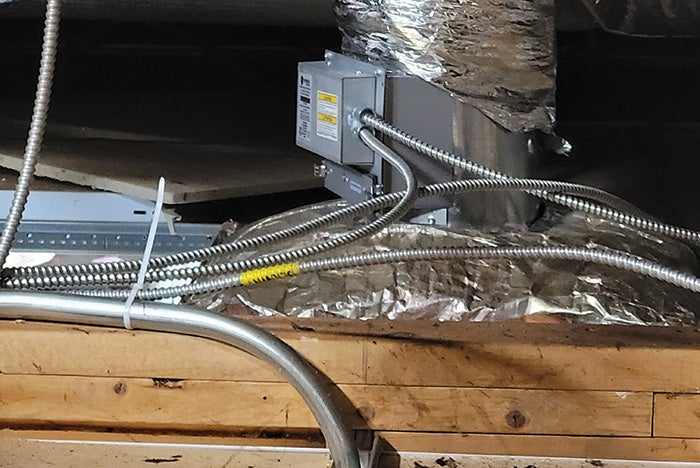Hospital fights curtain contamination

Synexis Blade, installed in the HVAC system, has improved the indoor environment at Sunrise Hospital & Medical Center in Las Vegas.
Photo courtesy of Synexis LLC.
The 834-bed Sunrise Hospital & Medical Center is the largest acute care facility in Las Vegas, and the only center of its kind in Nevada that offers a dedicated epilepsy monitoring unit.
The hospital serves the core of Las Vegas, including many patients who are experiencing homelessness and therefore may be at increased risk for contamination of harmful pathogens and microbes. Many of these patients are disproportionately affected by health care concerns, such as lice, maggots and other insects and microbes that thrive in contaminated environments. Patients bringing these pests into a hospital setting created a need for an extra layer of protection.
Jennifer Sanguinet, DrPH, is a principal investigator at Sunrise Hospital and often leads the charge in reducing the risk of infection for all patients. She says the organization has faced challenges in ensuring infection control safety, especially in regard to certain surfaces.
“It’s a requirement that we use privacy curtains, but no one has figured out how to cheaply, safely and effectively keep those curtains clean,” Sanguinet says.
Hospitals everywhere face challenges around constantly re-contaminating environments. Manual cleaning helps to address environmental risks and keep surfaces clean, but, as Sanguinet explains, “The minute somebody touches something, or sneezes or coughs near it, it’s contaminated again.” This was an especially taxing issue for the curtains hung between patient beds.
Sanguinet explored solutions such as manual cleaning and ultraviolet light disinfection, but couldn’t find a cost-effective answer for continuous disinfection that was safe for occupied rooms. This led her to discussions with Synexis LLC, Lenexa, Kan., which uses patented dry hydrogen peroxide (DHP) to attack microbes in the air and on surfaces. She also reviewed the science around DHP technology, leaving Sanguinet hopeful that she had found a cost-effective device to continuously fight microbes, even in occupied rooms.
She discussed implementing the Synexis BioDefense units with her colleagues, including her chief medical officer, the infection control committee, and nursing and engineering staff. The team members collectively decided to enter a trial period and put Synexis to the test.
Under Sanguinet’s direction, the hospital installed Blade BioDefense devices in the HVAC ductwork of five critical units. One unit each was placed in a 24-bed pediatric intensive care unit (ICU) and a 22-bed pediatric emergency department, both located in the Sunrise Children’s Hospital. The other three units were placed in Sunrise Hospital, specifically the adult oncology services, adult intensive care cardiovascular trauma unit and adult trauma surgical ICU.
The DHP units operate continuously and use ambient humidity and oxygen moving through the HVAC system along with a proprietary plasma separation process to generate hydrogen peroxide in a non-aqueous, dry gas form.
The research team conducted air and surface testing, taking samples from curtains, bed rails, countertops, proximity cabinets and nursing stations, along with air sampling for a broad spectrum of pathogens. The hospital maintained its same environmental cleaning and disinfection protocols during the course of the study.
The hypothesis they set was for continuous, sustained microbial reduction without changing other variables. The team even kept the study quiet among certain staff to ensure that manual cleaning didn’t increase or create bias.
The results? “While more study is necessary, the system worked as promised and reduced the air and surface microbe counts significantly,” Sanguinet reports.
From the published study, DHP resulted in an overall 96.5% microbial reduction for all combined surfaces. The greatest reduction in microbial burden was observed on the most difficult surface, the curtains, which documented a reduction of 99.5%.
In addition to reducing the count of “unseen” microbes, the hospital staff was able to see Synexis at work in their environment, as dead lice and retreating maggots were noted in hospital rooms where DHP technology was deployed.
“You can see it,” Sanguinet says. “If air can go there, Synexis can go there. DHP can go there.”

